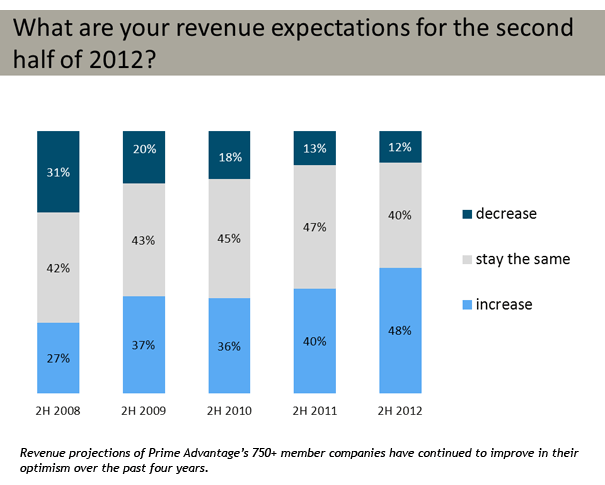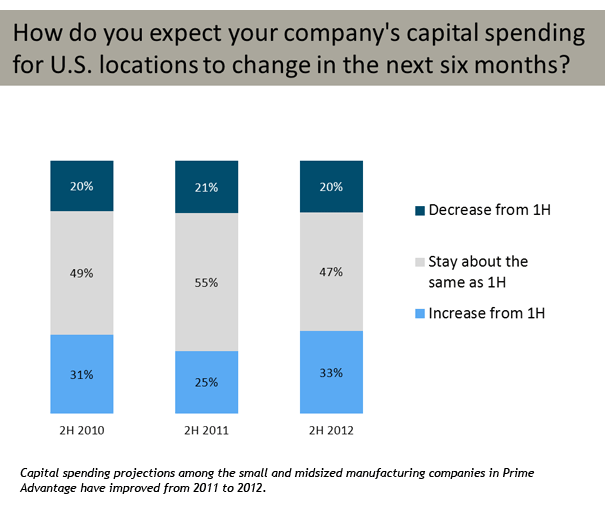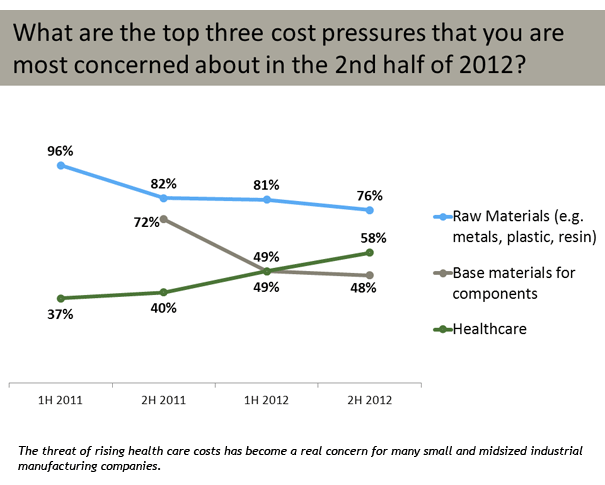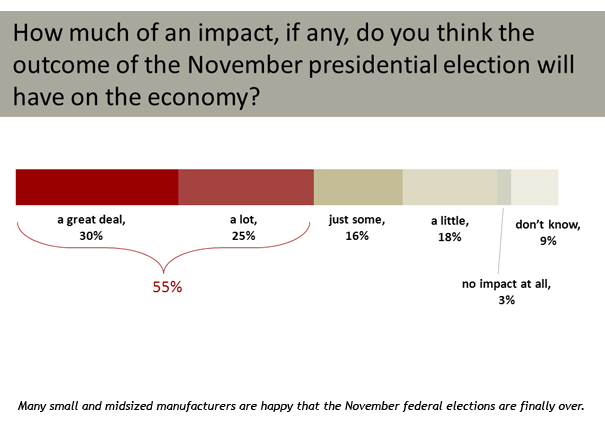
This article contains an analysis of recent surveys conducted in 2012 by the manufacturers buying group known as Prime Advantage. Comprised of more than 750 small and midsized industrial manufacturers throughout North America, the bi-annual Prime Advantage Group Outlook surveys offer unique insight into economic health and plans of these companies, as well as a useful portent of the health of these enterprises.
Many of the group’s recent projections on issues such as growth, hiring and raw materials costs are foretelling when compared to current economic data. The December 2012 Manufacturing ISM Report on Business, published on Jan. 2, 2013, reveals that new orders, new production and employment numbers all increased for the month. It also shows that many raw materials commonly used by industrial manufacturers increased in price in December (while also underscoring why the cost of raw materials is always a top concern of these small and midsized manufacturing companies). We encourage you to carefully read this article while considering your own plans for 2013.
For the past five years, Prime Advantage has been surveying its member companies twice annually on a variety of economic and operational issues that are common to small and midsized industrial manufacturing companies. Known as the Prime Advantage Group Outlook Survey, the findings offer unique insights into the buying habits of manufacturers over the coming six months. The manufacturers participating in the study are from more than 25 different industries, including commercial foodservice, packaging, truck and trailer, material handling, food processing and construction.
This article looks at data from our Group Outlook Surveys that were conducted in February and August 2010, 2011 and 2012, as well as the survey of our member companies’ CFOs in February 2012. The data reveal an outlook that is trending to increasing optimism for many small and midsized manufacturers in the U.S.
We start by looking at revenue projections, which is definitely a basis for the optimism, as 48% of respondents said they expected their revenues to increase in the second half of 2012. This compares favorably to responses from our fall surveys in 2011 and 2010, when 40% expected a revenue increase over the last half of the year in 2011, and just 36% expected a revenue increase over the last half of the year in 2010. An overall increase in customer demand was named the primary reason for the anticipated revenue growth to close 2012 in 58% of responses, followed by the planned introduction of new product lines (32%).

It is interesting to note that respondents to the 2012 McGladrey Manufacturing & Distribution Monitor said the introduction of new product lines was the most common strategy for business growth in the next 12 months.
In February, CFOs of our member companies offered a less-enthusiastic outlook for their companies in 2012, but the overall survey responses still improved from 2011, with 69% saying they were more optimistic about their financial prospects in 2012 (as opposed to 67% being optimistic about prospects in 2011).

Capital spending was also set to increase over the last half of 2012 for one-third of polled companies, an upward trend from a year ago, when only one-quarter of respondents budgeted an increase in capital spending.
Capital spending projections among the small and midsized manufacturing companies in Prime Advantage have improved from 2011 to 2012.
Shadowing the projected increase in capital spending is a projected increase in hiring. Overall, 90% of polled companies planned to either maintain or increase the number of domestic employees, with 39% of these planning to make hires through the end of 2012. These are higher rates when compared to the findings of our second-half 2011 survey, with just 35% indicating there would be new hiring.
These results are consistent with the Philadelphia Federal Reserve’s Business Outlook Survey from September 2012, where 32% of firms expected to increase employment over the next six months. This is a monthly survey of manufacturing purchasing managers who work in and around the tri-state area of Pennsylvania, New Jersey and Delaware. This survey, along with the Chicago NAPM Index, has shown high correlations to the well-read PMI report.
When asked to indicate the top three cost pressures causing the most concern for manufacturers over the last half of 2012, respondents most frequently cited the cost of raw materials. However, for the past three surveys, manufacturers have expressed lessening concern about raw material costs, relative to other cost pressures. In fact, only 76% of respondents included raw materials in their top three choices this time (down from 81% in the January 2012 Group Outlook survey study and 96% in the January 2011 study).

The McGladrey survey showed similar results on cost projections for raw materials and components, with 72% of respondents predicting that these costs would rise over the coming year.
Yet over the past year, Prime Advantage survey respondents have expressed more intense concern about cost pressure from healthcare benefits. The cost of medical care was voted the second greatest cost concern for manufacturers by nearly 60% of respondents. Only a year ago, concerns about healthcare costs were just the fourth greatest concern at 40%, and behind logistics (43%), components (72%) and raw materials (82%).
It is also useful to examine survey data around the recently completed federal elections. Of those who held an opinion about whether the November elections would cause a delay to some key business processes, 29% and 33% predicted delays in employment and capital spending respectively.

Similar to AP-GfK polling, we asked respondents about the level of impact the outcome of the presidential election could have on the economy and unemployment. A majority, 55% of respondents, and almost on par with a recent AP-GfK survey (48T), believed the impact on the economy would be felt greatly and 43% (40T in GfK) predicted an impact on unemployment.
See also:
Prime Advantage Group Outlook Survey -- February 2012.
Prime Advantage Group Outlook Survey -- August 2012.